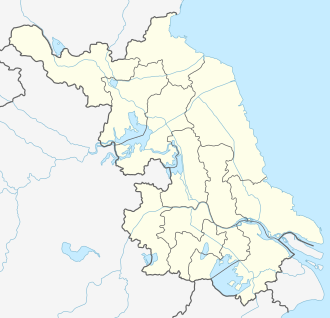Jintan District
Jintan District is a district under the administration of Changzhou in the Jiangsu province of the People's Republic of China.
Jintan
金坛区 Kintan | |
|---|---|
 Jintan Location in Jiangsu | |
| Coordinates: 31°43′19″N 119°31′44″E | |
| Country | People's Republic of China |
| Province | Jiangsu |
| Prefecture-level city | Changzhou |
| Subdivisions | 3 subdistricts, 6 towns |
| Area | |
| • Total | 976.7 km2 (377.1 sq mi) |
| Population (2016) | |
| • Total | 563,500 |
| • Density | 580/km2 (1,500/sq mi) |
| Time zone | UTC+8 (China Standard) |
| Postal code | 213200 |
| Jintan District | |||||||||||
|---|---|---|---|---|---|---|---|---|---|---|---|
| Simplified Chinese | 金坛 | ||||||||||
| Traditional Chinese | 金壇 | ||||||||||
| Postal | Kintan | ||||||||||
| |||||||||||
History
Jintan, known as Jinshan (金山) in ancient times, was a township of Yanling commandery since the reign of the Emperor Yuan of Jin. Then it was promoted by its inhabitants as Jinshan county to strengthen the local vigilance in the late Sui dynasty, without permission. As a densely populated area, the county was reestablished in about 688 under the Tang dynasty, but since there was a namesake in present-day Jinhua, Zhejiang, it was named after Jintan, a hill of Mao Mountain.[1][2]
Location
On November 10, 1993, Jintan was reclassified from a county and officially became a city. In 1987, the County comprised 22 towns, with the county government located in Jincheng town. The county was part of Changzhou, Jiangsu province. Jintan has a total area of 976.7 square kilometers (301.65 sq mi). The total land area is 781.27 square kilometers (301.65 sq mi), and water covers an area of 194.22 square kilometers (74.99 sq mi). As of 2010, it has a permanent resident population of 552,047. Jintan is a 2-3 hour bus ride from Shanghai.
Administrative divisions
In the present, Jintan District has 7 towns.[3]
- 7 towns
|
|
Dialect
Wu Chinese is the local dialect of Jintan. Some versions include the local dialect and the northern Jiangsu dialect. A fusion of languages has been created due to the geographical location of Jintan. The language habits of migrants have influenced the local language.
Environment
Geography and geomorphology
Western Jintan includes the mountainous region Maoshan, which covers an area of about 223 square kilometres (86 sq mi). The highest peak of Maoshan is 372.5 metres (1,222 ft) above sea level. Flatlands lie in the east of Jintan, part of the Taihu Plain, with an area of about 752 square kilometres (290 sq mi).
Lakes and Rivers
Jintan District has 216 rivers with a total length of 512 kilometres (318 mi). The southeast Tiao Lake (also named Changdang Lake), covers 8,200 hectares (32 sq mi). This lake is one of the ten largest freshwater lakes in Jiangsu province.
Climate
Jintan District comes under the Northern Subtropical Monsoon climate zone. Jintan City's climate is mild and humid with four distinct seasons. The annual average temperature is 15.3 °C (59.5 °F), while average annual precipitation is 1,063.5 millimetres (41.87 in). The frost-free period covers 228 days and the average humidity is 78%.
Notable people
- Duan Yucai (1735–1815), philologist
References
- New Book of Tang. 41. "金壇,緊。本曲阿縣地。隋末,土人保聚,因為金山縣。隋亡,沈法興又置琅琊縣,李子通以琅琊置茅州,以金山隸之。賊平,因之,後隸蔣州。武德八年省入延陵。垂拱四年復置,來屬,更名"; 太平寰宇記 [Gazetteer of the World during the Taiping Period]. 80. "垂拱四年,以人物繁廣復立金山縣。又以東陽郡已有金山縣,故改名金壇。取邑界句曲之山、金壇之陵以為號。按河圖云,乃有「地肺土良水清句曲之山金壇之陵」"
- The name of Jintan supposedly derives from a huge altar inside a cave on Mao Mountain. According to one account, the altar was golden, thus it was designated "Golden Altar". In another account, the altar was named after a hill nearby, Jijin(積金山), and abbreviated to Jintan. See 茅山志 [Gazetteer of Mao Mountain]. 6.
- "常州市-行政区划网 www.xzqh.org" (in Chinese). XZQH. Retrieved 2012-05-24.